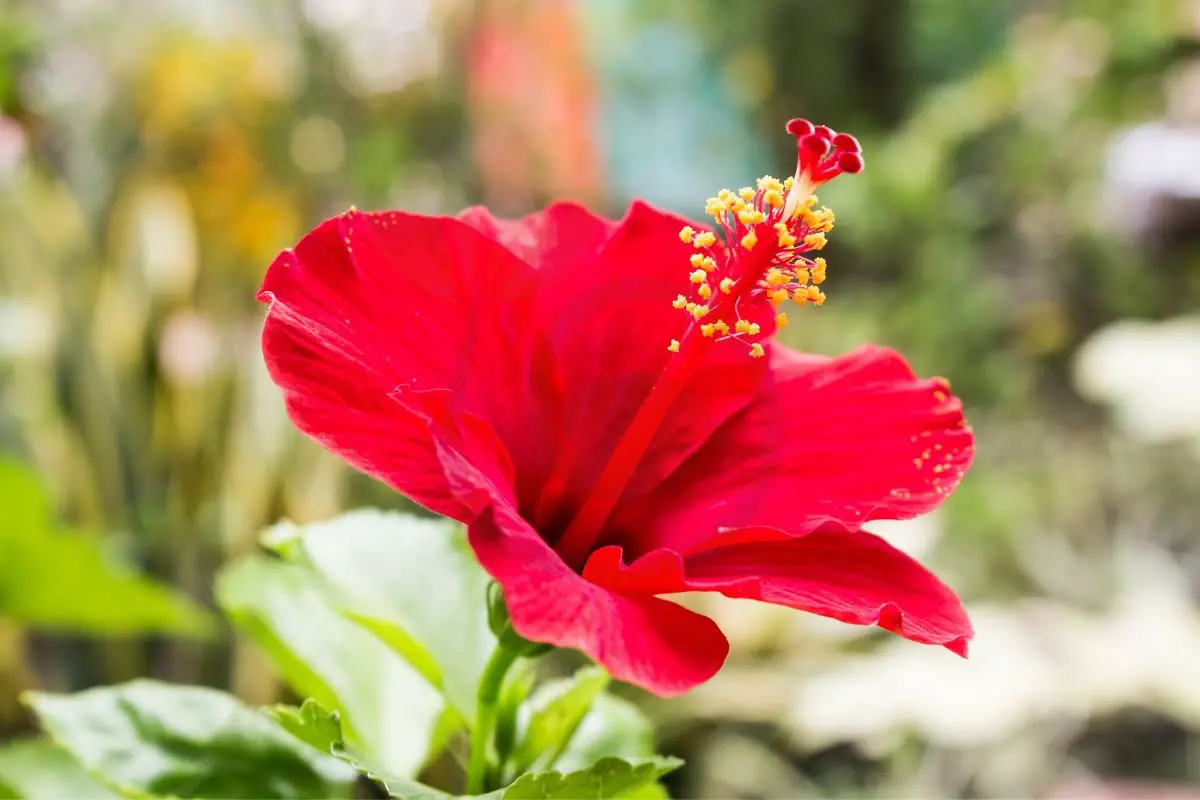Wondering how long a hibiscus flower lasts? We've got you covered with all the details you need. Hibiscus flowers, known for their vibrant colors and beauty, have an intriguing lifespan that varies based on several factors.
Curious to learn more about the longevity of these stunning hardy hibiscus blooms? Stay tuned as we delve into the fascinating world of hibiscus flowers, planting, and coffee, and uncover the secrets behind their duration. Whether you're a gardening enthusiast or simply appreciate the allure of these blossoms, this insightful guide will provide you with valuable insights into the lifecycle of hibiscus flowers.
Key Takeaways
- Provide optimal growing conditions: Ensure your hibiscus plant receives adequate sunlight, water, and well-draining soil for healthy blooms.
- Monitor nutrient levels: Regularly feed your hibiscus plant with a balanced fertilizer to support vibrant and long-lasting flowers.
- Practice proper watering techniques: Water your hibiscus plant deeply but infrequently, allowing the soil to dry out slightly between waterings to prevent root rot.
- Regular pruning and maintenance: Trim dead or damaged branches, and remove spent flowers to encourage new blooms and maintain plant health.
- Prevent pests and diseases: Keep an eye out for common hibiscus pests like aphids and spider mites, and address any issues promptly to protect your plant's blooms.
- Enhance bloom longevity: Support your hibiscus flowers by providing consistent care, monitoring for signs of stress, and adjusting care practices as needed.
Hibiscus Bloom Overview
Bloom Duration
Hibiscus flowers typically last for one to two days, showcasing their vibrant colors before wilting. Different hibiscus species vary in bloom duration, with some lasting longer than others. Hybrids have been developed to extend the blooming period of hibiscus flowers, providing a more prolonged display in gardens.
Varietal Differences
Tropical Hibiscus
- Tropical hibiscus plants exhibit unique blooming patterns, often producing flowers year-round in suitable climates.
- These plants thrive in warm, humid environments and require consistent watering and sunlight for optimal blooming.
- In tropical regions, the continuous blooming cycle of tropical hibiscus adds a splash of color to landscapes throughout the year.
Hardy Hibiscus
- Hardy hibiscus varieties are known for their extended blooming periods, with some species flowering from summer to fall.
- These plants have different blooming habits based on their species, offering a diverse range of colors and bloom sizes.
- Understanding the specific requirements of each hardy hibiscus variety can help gardeners maximize their blooming potential.
Seasonal Impact
Seasons play a crucial role in influencing the blooming behavior of hibiscus flowers. Different seasons bring about changes in temperature, daylight hours, and humidity levels that impact the blooming intensity of hibiscus plants. Optimal blooming periods for hibiscus vary depending on the species and environmental conditions present during each season.
Optimal Growing Conditions
Sunlight Exposure
Hibiscus plants thrive in direct sunlight for at least six hours daily. Insufficient sunlight can lead to fewer blooms and slower growth of new branches. Proper sunlight exposure is crucial for ensuring vibrant and long-lasting hibiscus flowers.
Watering Practices
Consistent Schedule
Maintaining a regular watering schedule benefits hibiscus plants by promoting healthy growth. Consistency in watering helps regulate the plant's moisture levels, supporting optimal blooming. A steady care routine throughout the year enhances the overall health and blooming frequency.
Avoid Excess
Excessive watering or fertilizing can harm hibiscus plants, affecting their blooming capacity. Moderation in care practices, including watering and fertilization, is essential for flower longevity. By avoiding overindulgence in care routines, you can prolong the lifespan of hibiscus blooms.
Soil Health
Preparation Techniques
Effective soil preparation methods contribute to robust and healthy hibiscus blooms. Pre-blooming care actions, such as proper soil conditioning, play a vital role in flower longevity. Ensuring the soil is well-prepared maximizes the potential for abundant hibiscus blossoms.
pH Maintenance
Maintaining the optimal pH level is crucial for sustaining vibrant hibiscus flowers. The recommended pH range for hibiscus plants supports their overall health and blooming vigor. Proper pH maintenance directly impacts the extended lifespan of hibiscus blooms.
Planting and Repotting
Site Selection
Choosing the right planting location is crucial for hibiscus plants to thrive. Ensure the site receives full sunlight for at least six hours daily. well-draining soil is essential to prevent waterlogging, promoting healthy root growth.
To promote robust hibiscus blooms, select a site with protection from strong winds, which can damage delicate flowers. Avoid areas prone to frost or extreme cold, as hibiscus plants are sensitive to low temperatures. Proper site selection directly impacts the longevity of hibiscus flowers, ensuring they bloom vibrantly for an extended period.
Planting Practices
When planting hibiscus, ensure the root ball is placed at the same level as the surrounding soil in the chosen container. Gently tamp down the soil around the plant to eliminate air pockets that can hinder root development. Water thoroughly after planting to support initial growth.
Effective planting practices involve providing adequate watering and fertilization throughout the growing season. Mulching around the base of the plant helps retain moisture and suppresses weed growth, contributing to long-lasting blooms. By following these best techniques, you can ensure your hibiscus thrives and produces an abundance of colorful flowers.
Repotting Guidelines
Repotting hibiscus plants is essential for maintaining their health and prolonging flowering periods. The optimal time for repotting is in early spring before new growth emerges, allowing the plant to adjust to its new container comfortably. Use a slightly larger pot than the current one to accommodate root growth.
Proper repotting techniques involve gently loosening the roots before placing them in fresh potting mix. Ensure good drainage in the new container to prevent waterlogging, which can lead to root rot. By adhering to these guidelines, you can support continuous blooming cycles in your hibiscus plants.
Nutrient Management
Fertilization Methods
Regular Schedule
- Consistent care routine is vital for sustaining hibiscus blooms, ensuring they thrive and last longer.
- Sticking to a regular schedule for hibiscus plant care helps maintain optimal nutrient levels.
- A consistent care routine significantly contributes to the prolonged lifespan of hibiscus flowers.
Epsom Salt Benefits
- Enhance blooming by using Epsom salt, which provides essential nutrients for healthy hibiscus growth.
- Epsom salt has positive effects on the longevity of hibiscus flowers, promoting vibrant and lasting blooms.
- Incorporating Epsom salt into your care routine can result in healthier and more robust hibiscus blooms.
Coffee Grounds Use
- Using coffee grounds is advantageous for boosting blooming, as they enrich the soil with essential nutrients.
- Coffee grounds have a positive impact on the health and longevity of hibiscus flowers, aiding in their sustained vibrancy.
- The utilization of coffee grounds can improve blooming performance, leading to more abundant and colorful hibiscus plants.
Watering Techniques
Appropriate Amounts
Using appropriate amounts of water and fertilizer is crucial for hibiscus care. Correct dosages directly impact the blooming frequency and duration of hibiscus flowers. By applying the right quantities of water and nutrients, you can significantly extend the lifespan of hibiscus blooms.
Mulching offers several benefits for ensuring healthy hibiscus blooms. It plays a vital role in enhancing soil quality by improving its structure and fertility. Mulching aids in retaining moisture, which is essential for the overall well-being of hibiscus plants. By employing mulching techniques, you can support prolonged blooming periods for your hibiscus flowers.
Pruning and Maintenance
Trim for Blooms
Proper trimming practices play a crucial role in encouraging hibiscus blooming by stimulating new growth. By trimming correctly, you can promote flower production and increase the frequency of blooms. Strategic trimming helps in extending the longevity of hibiscus flowers, ensuring a vibrant display throughout the season.
- Trim hibiscus plants by cutting just above a leaf node to encourage new growth.
- Use sharp and clean pruning shears to prevent damage to the plant while trimming.
- Avoid cutting more than one-third of the plant's total height to maintain its health and vigor.
Remove Spent Flowers
Removing spent flowers is essential for encouraging continuous blooming in hibiscus plants. Deadheading, or the removal of faded blooms, promotes new bud development and enhances the overall vitality of the plant. Regularly removing spent flowers ensures that the plant channels its energy into producing fresh blooms, extending the blooming season significantly.
- Deadhead hibiscus flowers by pinching off wilted blooms at their base to stimulate new growth.
- This practice prevents seed formation, redirecting nutrients towards promoting additional flowering.
- Regular deadheading not only maintains an attractive appearance but also supports prolonged blooming periods.
Regular Pruning
Regular pruning is key to maintaining healthy hibiscus blooms and sustaining flower production. By consistently removing dead or overgrown branches, you create space for new growth and improve air circulation around the plant. Optimal pruning techniques support continuous flower production by encouraging branching and enhancing overall blooming performance.
- Prune hibiscus plants during their active growing season to avoid stunting growth.
- Remove any diseased or damaged branches to prevent the spread of infections within the plant.
- Consistent pruning encourages the development of strong stems and promotes abundant flowering.
Pest and Disease Prevention
Identify Common Issues
Hibiscus plants are susceptible to pests and diseases that can hinder their blooming. Common issues include aphids, spider mites, and fungal infections. These problems often manifest as yellowing leaves, deformed flowers, or stunted growth.
To ensure prolonged hibiscus flower longevity, it's crucial to promptly address these issues. By regularly inspecting your plants for signs of pests or diseases, you can take early action to prevent further damage. Implementing organic pest control methods like neem oil can effectively combat these common problems.
Preventive Measures
Implementing preventive measures is key to protecting hibiscus blooms from potential threats. Regularly pruning dead or diseased branches helps improve air circulation around the plant, reducing the risk of fungal infections. Providing adequate sunlight and well-draining soil can boost plant health and resilience.
Proactive strategies such as applying a balanced fertilizer during the growing season can enhance the plant's immune system against diseases. Mulching around the base of the plant helps retain moisture and regulate soil temperature, creating an optimal environment for healthy blooming. By adopting these preventive measures, you can ensure vibrant and long-lasting hibiscus flowers.
Enhancing Bloom Longevity
Ideal Conditions
Creating ideal growing conditions is crucial for vibrant hibiscus blooms. Adequate sunlight, well-draining soil, and regular watering are essential. These factors promote healthy growth and encourage prolific flowering in hibiscus plants. Providing the right balance of nutrients through fertilization also plays a key role in maximizing bloom longevity.
To support healthy hibiscus flower development, ensure your plants receive at least six hours of direct sunlight daily. Hibiscus thrives in warm temperatures between 60-90°F (15-32°C). Maintaining well-drained soil with a slightly acidic pH level (6.0-6.5) is vital. Proper air circulation around the plant helps prevent fungal diseases that can affect blooming.
Maximize the blooming potential of your hibiscus by creating an environment that mimics their native tropical habitats. Consider using mulch to retain moisture and regulate soil temperature. Pruning dead or overgrown branches encourages new growth and enhances flower production.
Timely Care Techniques
Timely care techniques are paramount for sustaining hibiscus blooms over an extended period. Regularly inspect your plants for pests, diseases, and nutrient deficiencies to address issues promptly. Swift action can prevent problems from escalating and impacting the longevity of hibiscus flowers.
Addressing care needs promptly is crucial to supporting hibiscus flower longevity. Monitor soil moisture levels regularly to ensure consistent hydration without waterlogging the roots. Deadhead spent blooms to encourage continuous flowering throughout the growing season. Implementing a regular fertilization schedule tailored to hibiscus plants' specific needs boosts overall health and blooming capacity.
Enhance the overall blooming performance of your hibiscus plants by implementing timely interventions when necessary. Treat any pest infestations promptly using organic or chemical solutions as needed. Prune damaged or diseased parts of the plant to promote new growth and prevent further spread of issues.
Seasonal Care Tips
Winter Preparations
To protect hibiscus plants during winter, understand the essential preparations required. Implement winter care practices to help hibiscus survive colder temperatures. Proper winter preparations are vital for ensuring the return of healthy blooms in the following season.
Summer Maintenance
Support hibiscus plants during summer by focusing on key maintenance practices. Learn about the specific care needs of hibiscus plants in hot weather conditions. Summer maintenance routines play a crucial role in promoting continuous blooming of hibiscus flowers.
Final Remarks
You've now mastered the art of keeping your hibiscus blooms vibrant and lasting longer. By understanding their needs, providing optimal care, and staying vigilant against pests and diseases, you can ensure your hibiscus plants thrive throughout the seasons. Remember to water wisely, nourish adequately, and prune strategically to promote continuous blooming and overall plant health. Your dedication will be rewarded with a garden full of stunning hibiscus flowers that brighten up your outdoor space.
Take the knowledge you've gained here and apply it to your hibiscus care routine. Share these tips with fellow gardeners to spread the joy of flourishing hibiscus plants. Keep nurturing your green thumb, and watch as your garden transforms into a colorful oasis of beauty and serenity.
Frequently Asked Questions
How long does a hibiscus flower typically last?
Hibiscus flowers usually last for one day before wilting and falling off the plant. However, new blooms will appear daily during the flowering season.
What are the optimal growing conditions for hibiscus plants?
Hibiscus plants thrive in full sun with well-draining soil. They prefer warm temperatures between 60-90°F and high humidity levels to promote healthy growth and abundant flowering.
When is the best time to prune hibiscus plants for maintenance?
Prune hibiscus plants in late winter or early spring before new growth begins. Remove dead or damaged branches, shape the plant, and encourage new growth by cutting back up to one-third of the branches.
How can I prevent pests and diseases from affecting my hibiscus plant?
Regularly inspect your hibiscus plant for signs of pests like aphids or diseases such as powdery mildew. Use organic insecticidal soap or neem oil to treat infestations and ensure good air circulation around the plant.
How can I enhance the longevity of hibiscus blooms?
To prolong the lifespan of hibiscus blooms, deadhead spent flowers regularly to encourage new growth. Provide adequate water and nutrients, ensure proper sunlight exposure, and protect the plant from extreme weather conditions.
Image Source: Paid image from CANVA




